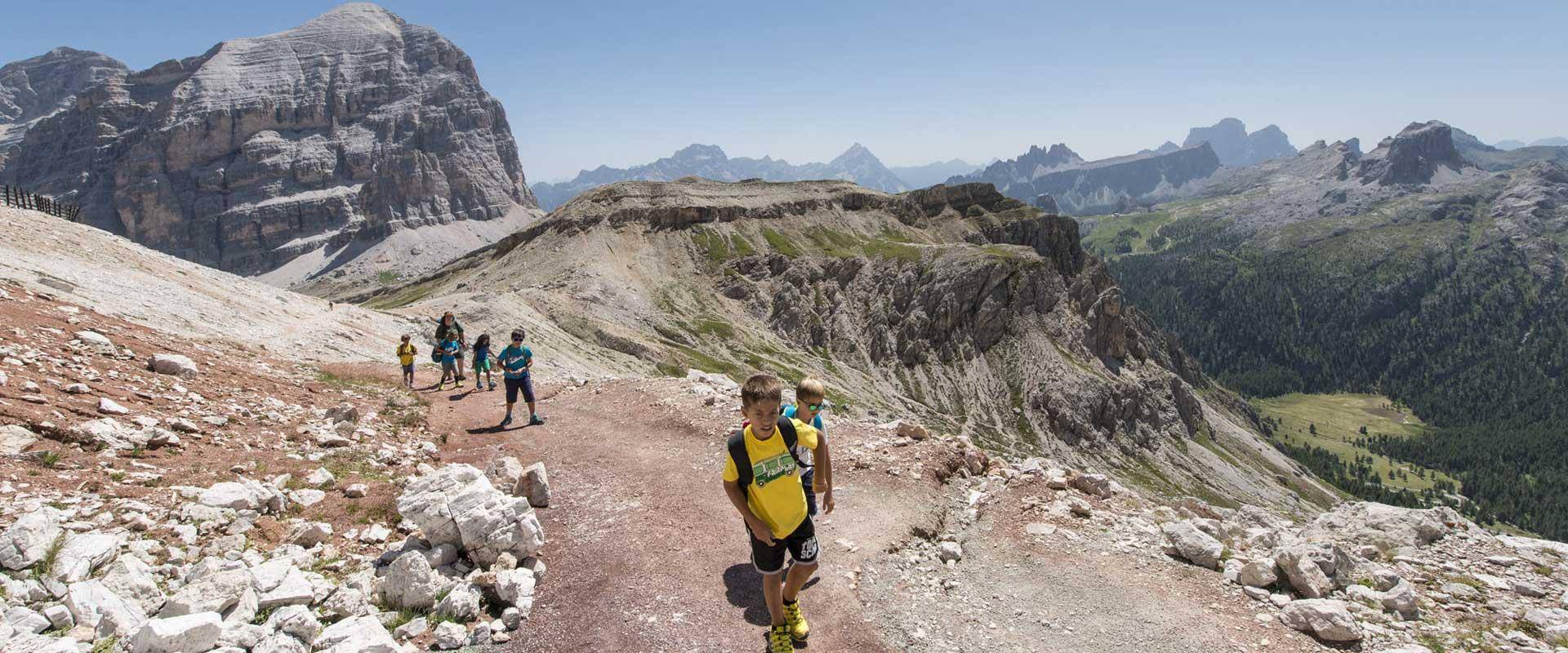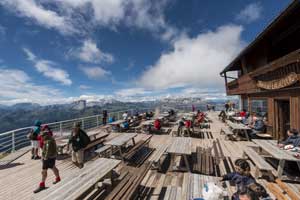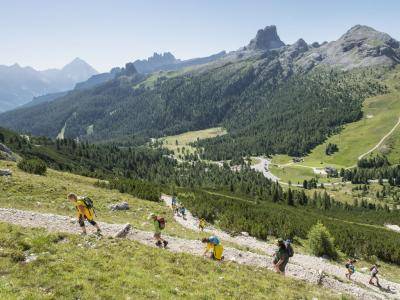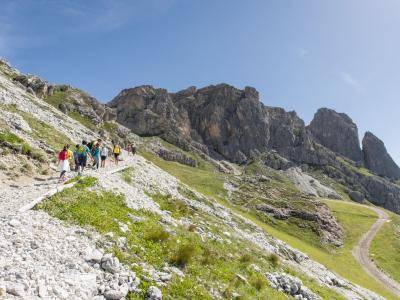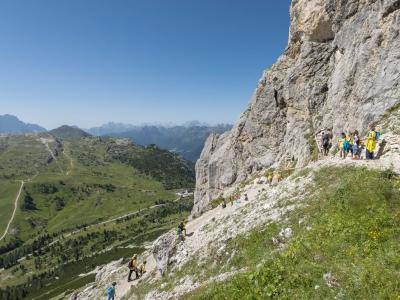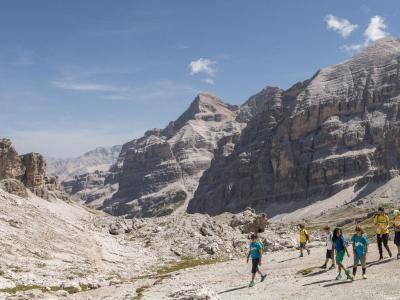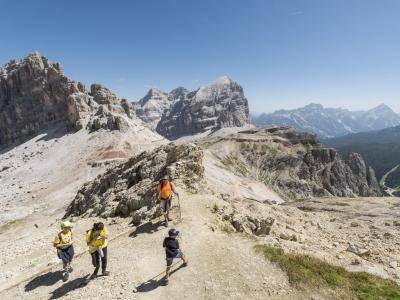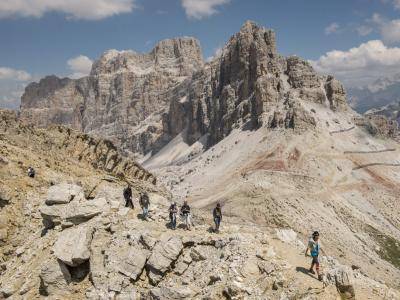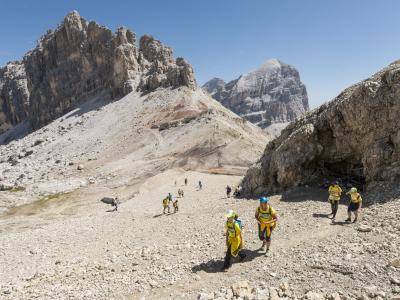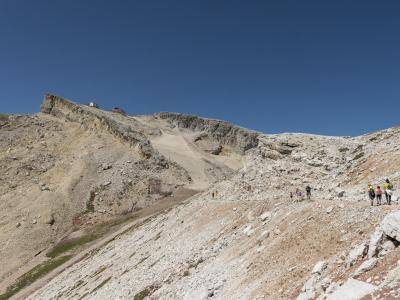During World War 1 the current parking of the cable car Lagazuoi was no man's land. The Austrian trenches on the Vonbank emplacement blocked the passage between the western mountainsides of Mount Lagazuoi and Sasso di Stria and impeded the access to the Val Badia. The Italian trenches reached from the east slope of the Lagazuoi and the hut Col Gallina, and from here up to the summit of the Col Gallina. On moonless nights the Italian and Austro-Hungarian reconnaissance patrols were on the scout to explore the enemy defences and to damage or neutralize, whenever possible, the barbed wire which was laid in three rows in front of the trenches. In winter this activity was particularly difficult and dangerous, because with the white snow and under the moonlight the enemy had a very good view.
The trail no. 401 crosses the Italian trenches, which starts from the Italian armoured turret at the foot of Mount Lagazuoi and runs zigzagging uphill among the Italian emplacements of the Berrino Point. These emplacements were protected against the bombardment of the Austrian artillery positioned on the Sasso di Stria and therefore pretty sure. Here starts the hiking trail to the Italian mine gallery. The trail n. 401 runs along the soldiers' camp where the remains of the buildings in which the Italian soldiers lived are still visible.
The emplacement was well protected, only in the direction of the saddle Forcella Travenanzes the soldiers exposed to the Austrian machine gun fire from Mount Grande Lagazuoi and the gap Forcella Lagazuoi. To reach Forcella Travenanzes, you must cross again the no man's land. This area was directly in the line of fire of the Italian machine guns positioned on Col dei Bos (the loopholes in the rock are clearly visible) and at Berrino Point, but also of the Austrian artillery placed on the Muraglia Rocciosa (Rocky Wall), on the Lagazuoi saddle and on the Great Lagazuoi. The saddle Forcella Travenanzes was defended by a trench which has been destroyed. The trail leading to up to Mount Lagazuoi crosses the mountainside of the Great Lagazuoi. And precisely on this path the Austro-Hungarian soldiers transported munitions and food to the positions on the saddle Forcella Travenanzes, at the Castelletto and on the saddle Forcella Fontana Negra. The transport activities were very dangerous. The bearers had to walk during the night and in a complete silence but often they were illuminated by flares and attacked by the enemy. At the front each soldier needed about 70 kg of material per day. The word material consisted of ammunition, food, water, building materials and everything necessary to survive in the mountains. That's why the carriers had to go up and down this route very often.
The Lagazuoi saddle was defended by three rows of barbed wire and by a trench which ran from the crest “Muraglia Rocciosa” to the Great Lagazuoi and leaned against a rocky promontory called the bow. Here you can still see the loopholes of the Austro-Hungarian emplacements. The crest “Muraglia Rocciosa” was an insurmountable obstacle for the Italian soldiers who were trying to attack their enemies from the Berrino point and from the no man's land, where now runs the ski slope. this emplacement was supplied by a long material cable way. The valley station was Capanna Alpina and she passed by Scottoni refuge.
The trail no. 402 winds along the Austrian emplacements on the crest “Muraglia Rocciosa”. It is a series of emplacements dug into the rock with loopholes for machine guns pointed at Berrino point and Col dei Bos. Besides the emplacements you can see the remains of the Austrian barracks. These were realized in niches, which the soldiers had previously dug into the rock in order to better protect themselves from the shrapnel of the Italian 75 mm guns. The defensive line went up to the end of the crest “Muraglia Rocciosa” where now you can see the emplacement FW4 with the machine gun (Feldwache 4) and then turned westwards, where now there are the cable car and the mountain hut Rifugio Lagazuoi. From here, the defensive line reached the summit of Mount Lagazuoi and joined the Kaiserjäger path.
